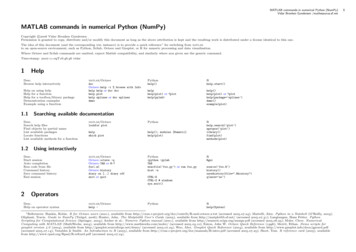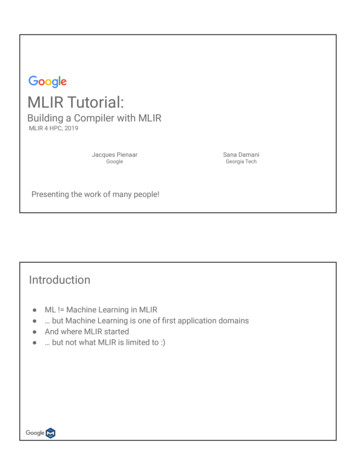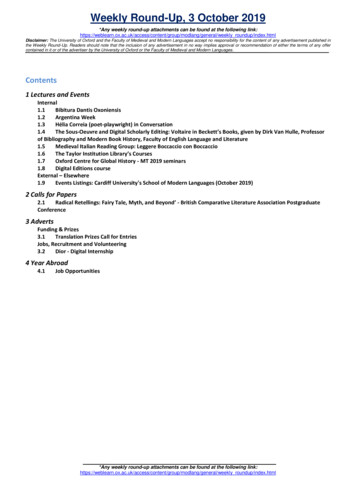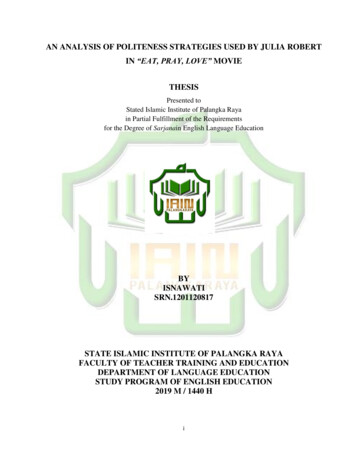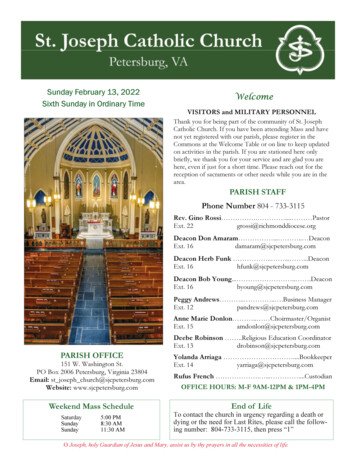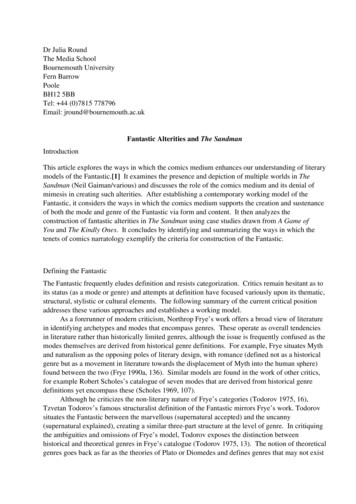
Transcription
Dr Julia RoundThe Media SchoolBournemouth UniversityFern BarrowPooleBH12 5BBTel: 44 (0)7815 778796Email: jround@bournemouth.ac.ukFantastic Alterities and The SandmanIntroductionThis article explores the ways in which the comics medium enhances our understanding of literarymodels of the Fantastic.[1] It examines the presence and depiction of multiple worlds in TheSandman (Neil Gaiman/various) and discusses the role of the comics medium and its denial ofmimesis in creating such alterities. After establishing a contemporary working model of theFantastic, it considers the ways in which the comics medium supports the creation and sustenanceof both the mode and genre of the Fantastic via form and content. It then analyzes theconstruction of fantastic alterities in The Sandman using case studies drawn from A Game ofYou and The Kindly Ones. It concludes by identifying and summarizing the ways in which thetenets of comics narratology exemplify the criteria for construction of the Fantastic.Defining the FantasticThe Fantastic frequently eludes definition and resists categorization. Critics remain hesitant as toits status (as a mode or genre) and attempts at definition have focused variously upon its thematic,structural, stylistic or cultural elements. The following summary of the current critical positionaddresses these various approaches and establishes a working model.As a forerunner of modern criticism, Northrop Frye’s work offers a broad view of literaturein identifying archetypes and modes that encompass genres. These operate as overall tendenciesin literature rather than historically limited genres, although the issue is frequently confused as themodes themselves are derived from historical genre definitions. For example, Frye situates Mythand naturalism as the opposing poles of literary design, with romance (defined not as a historicalgenre but as a movement in literature towards the displacement of Myth into the human sphere)found between the two (Frye 1990a, 136). Similar models are found in the work of other critics,for example Robert Scholes’s catalogue of seven modes that are derived from historical genredefinitions yet encompass these (Scholes 1969, 107).Although he criticizes the non-literary nature of Frye’s categories (Todorov 1975, 16),Tzvetan Todorov’s famous structuralist definition of the Fantastic mirrors Frye’s work. Todorovsituates the Fantastic between the marvellous (supernatural accepted) and the uncanny(supernatural explained), creating a similar three-part structure at the level of genre. In critiquingthe ambiguities and omissions of Frye’s model, Todorov exposes the distinction betweenhistorical and theoretical genres in Frye’s catalogue (Todorov 1975, 13). The notion of theoreticalgenres goes back as far as the theories of Plato or Diomedes and defines genres that may not exist
alongside those that do. Todorov then proceeds to create a similarly theoretical model of theFantastic. His critique of Frye seems supported (for example by Frye’s own insistence in hiswork on the autonomy of literary criticism (Frye 1990a, 6) while denying any such selfsufficiency to his literary categories), and Todorov’s structuralist model remains the cornerstonedefinition of the Fantastic to date.Todorov identifies three textual levels within his critical model (the verbal, the syntacticaland the semantic) and proposes that the "moment of hesitation" that defines the Fantastic may belocated on any of these levels (1975, 20). Whereas previously this hesitation commonly referredto perception (and therefore was most often found in the verbal area – referring to both theutterance itself and its performance, and thereby involving both the speaker/narrator and thelistener/reader), Todorov proposes that language has now replaced perception as the definingfactor of fantastic discourse. Consequently he concludes that hesitation is also observable both inthe syntactical relations between different parts of the text, and in its semantic content (its themes,which he identifies as being either of the self or the other).By specifically addressing the Fantastic and adding a syntactic dimension, Todorov’s studybreaks with previous criticism. Much of this touches on the Fantastic only as a part of a widercategorization of literary criticism (Frye) or generic theory—as Robert Scholes describes his ownwork: situating it between the generalizations of modal theory and the preciseness of genre study(1969, 111). Even those studies specifically directed at the Fantastic (such as John Cawelti’swork on deductive genre theory, or the formalist work of Vladimir Propp) focus only on the text’ssemantics.Of the preceding studies, Propp’s Morphology of the Folktale (first published 1928) isperhaps the most significant. It explores the text at the narrative level, focusing on its overtcontent and themes. Through syntagmatic analysis of individual narratives, Propp identifies thirtyone functions that he claims are common to the narrative structure of all Russian wondertales. Byfocusing exclusively on this limited body of work, Propp’s study also includes an implicit culturalelement, although this is not explicitly considered in Morphology. However, Propp’s later book,Theory and History of Folklore, expands upon his earlier observations to consider the semanticsof his wondertales in a cultural context: concluding that folklore reinterprets the images of the oldsocial system in order to depict the unusual in impossible dimensions (1984, 11).Propp also comments (somewhat more widely) that, in this way, genres may be classifiedaccording to their relationship with reality:The character of a genre is determined by the kind of reality it reflects, the means by whichreality is expressed, the relation to reality, and its assessment. Unity of form results in unityof content, if by content we understand not only the plot but also the intellectual andemotional world reflected in the work. It follows that unity of form is sustained byeverything called content and that the two cannot be separated. (1984, 41)In this way Propp gives his semantic study a syntactical dimension and, although the resultingmodel has been criticized (for example by Claude Lévi-Strauss), it has also been successfullydefended.[2]Subsequent criticism has built upon these previous models in various ways. Defining theFantastic in terms of its relationship with reality is further supported by the work of KathrynHume, who defines fantasy as one of the overall impulses (together with mimesis) that underlie allliterature (Hume 1984, xii) and subdivides it into four different modes according to its response to
reality (55). While this inclusive definition is certainly non-restrictive it is of small help indefining exactly what fantasy might be except a departure from reality.Rosemary Jackson’s Fantasy: The Literature of Subversion (1981) seeks "to extend Todorov’sinvestigation from being one limited to the poetics of the Fantastic into one aware of the politicsof its forms" (Jackson 1981, 6) in order to consider the cultural formation of the Fantastic.Jackson also defines the Fantastic/fantasy (she uses the two terms interchangeably) as a mode thatassumes different generic forms (32) and uses a linguistic metaphor (which parallels Claude LéviStrauss’s structuralist approach to Myth) to clarify this. The mode of the Fantastic is the languefrom which various parole (genres or forms) derive, according to its interpretation and thesurrounding historical situation (7).Jackson has been criticised most for her indiscriminate use of terminology (see for example Traill 1996, 6 andCornwell 1990, 27), but her work does introduce two important terms: "alterity" and "paraxis." "Fantasy re-combinesand inverts the real, but it does not escape it: it exists in a parasitical or symbiotic relation to the real" (20). Fantasticworlds are therefore alterities – "this world re-placed and dis-located" (19), and Jackson defines this process oftransformation and replacement as paraxis – signifying "par-axis," being that which lies alongside themain body (or axis) (19). Jackson further notes the significance of her optical metaphor (paraxisis a technical term referring to an illusory area of perceived unity after light refraction), alerting usto the significance of perception in defining the Fantastic.In adding a cultural dimension to Todorov’s model, Jackson’s criticism is largely semantic in nature, and muchof her study is concerned with identifying the Fantastic’s themes (such as invisibility, transformation, and dualism)and motifs (vampires, mirrors, shadows, ghosts, madness, and dreams) in her selected texts. It is again worth notingthat all these revolve around difficulties of perception and the problematization of vision (45). However, she doesalso apply her criticism, albeit briefly, to the syntactical dimensions of the text, supporting Todorov’s model incommenting that anxiety and hesitation may be found in the work’s structure (28). Nonetheless, her work is not ableto provide a new model for future criticism, but instead uses Todorov’s model to inform a series of observations thatconnect a variety of works in terms of their structural characteristics and underlying semantic themes.Subsequent criticism has continued to redefine Todorov’s model in a similar manner, using stylistic andsemantic deconstructions of fantastic literature to justify modifications. In A Rhetoric of the Unreal (1981),Christine Brooke-Rose attempts to define the Fantastic stylistically, providing an analysis ofprevious critical models and genre-based theories. She redefines Todorov’s notion of hesitation interms of the text’s implied author and reader (as well as its narrator and narratee) and analyzes thetext’s related stylistic features. She concludes that the textual codes used are necessarily eitherover- or under-determined: we are given either too much (conflicting) information, or not enough,which sustains the Fantastic (Brooke-Rose 1981, 112). Not for the first time, attention is drawn tothe stylistic strategies common to the Fantastic, such as unreliable narration.Later critics’ work continues in this vein, reassessing and adapting Todorov’s model in order to both refine itsapplicability and inform discussion of the types of strategies common to the Fantastic. A.B. Chanady’s MagicalRealism and the Fantastic (1985) attempts to clarify and distinguish between these two terms,treating them as similar modes. Commenting that "critics do not even agree whether it is a mode,a genre or an attitude towards reality" (1985, 1), Chanady goes on to draw attention to theconfusions of Todorov’s system (where despite naming the Fantastic as a genre, he nonethelesssituates it between two modes (1)). She instead adds the Fantastic to Robert Scholes’s catalogueof seven modes and discusses it at this level.Although she does not adopt Jackson’s alterity terminology, Chanady also notes that fantastic literature is setin a world "very similar" (though not identical) to our own (5), in contrast to fairy tale, which takes place in the worldof the outright marvellous. She defines three criteria for the presence of the Fantastic/magical realism: the copresence of the natural and supernatural; antinomy between the two; and authorial reticence (31). The treatment ofthese factors is, for Chanady, the distinguishing factor between magical realism and the Fantastic: whereas the copresence of the natural and supernatural is normalized by the presence of a realistic framework in magical realism,this is denied in the Fantastic. The antinomy of the supernatural and natural is thereby resolved in magical realism
and authorial reticence leads to acceptance, whereas such contradictions are foregrounded in fantastic literature anduncertainty prevails (11).Chanady’s attempt to distinguish between the two terms is made less clear for some readers by her use ofSpanish-American narratives, which are included without translation. However, her method leads to closer study ofthe strategies used to enable authorial reticence (such as singularization) and she concludes by suggesting furtherareas for research that include the character of the narrator, use of subjectivity, characteristics of enunciation, andcloser analysis of structural elements such as the use of suspense, suggestion and so forth.Neil Cornwell’s study The Literary Fantastic (1990) seeks to link the Fantastic to both gothicand postmodern literature and in so doing offers a comprehensive literature review of many of themodels examined thus far. For Cornwell’s purposes, Todorov’s genre theory of the Fantasticexists within the broader mode that Cornwell names as fantasy, although he notes that fantasy alsoexists as a sub-genre (for example Tolkien-esque fiction), and in addition defines the Fantastic asa quality that may be found in works such as the uncanny (31).Cornwell also looks backwards to gothic fiction and aligns David Punter’s definition of "paranoiac fiction"with the Fantastic (53). In this sense he again strengthens the case for consideration of the Fantastic as an overallmode rather than a historically limited genre – and goes on to criticise the narrow period from which Todorov’sexamples are drawn (141). Although it is clear that many of the best examples of fantastic fiction are to be found incertain eras, its applicability to the disparate periods of gothic and postmodernism refutes such a limitation.Cornwell’s work therefore aligns with Jackson’s in treating the Fantastic as a mode that assumes various formsaccording to its historical context.As Cornwell notes, the literary Fantastic has many similarities with the postmodern, a link further supportedby his identification of the current preponderance of fantastic literature. Similarly, Scholes’s definition ofcontemporary writing as fragmented and distorted applies equally to both the Fantastic and modernist/postmodernistfiction. Some of the more general surrounding literary criticism further emphasises this point.This includes Romancing the Postmodern (1992), in which Diane Elam links the "excesscharacteristic" (Elam 1992, 1) of romance to postmodernism: considering romance both as apostmodern genre and as postmodernism itself (12). In so doing, she treats postmodernism not asfollowing modernism, but as its counter-discourse (3), commenting that "postmodernism does notsimply happen after modernism but is a series of problems present to modernism in its continuinginfancy" (9) and hence focusing on texts that are problematized by their inclusion of romance (4).In my view, by situating romance in opposition to literary realism, defining it as "excess",commenting that its character remains "an uncertainty" (7), and focusing on its problematictendencies, Elam’s treatment of the concept may inform discussion of the Fantastic (if not outrightfantasy). She also adds a gender dimension to her study in her consideration of woman "as thefigure of the self-excess of romance" (17).Bruno Latour takes a similar perspective on the coexistence of modernism and postmodernism in We HaveNever Been Modern (1993), arguing that the historically limited genres of modernism andpostmodernism are illusory and that, in fact, modernism has never existed in accordance with itsown constitution. As such, he defines postmodernism not (as it presents itself) as the end ofhistory, but instead locates it in the perpetual impasse of the avant-garde (Latour 1993, 62). In sodoing, his work, like Elam’s, accords with Jean-François Lyotard’s definition of postmodernism,as "not modernism at its end but in the nascent state, and this state is constant" (Lyotard 1984, 79).A similar revelation exists in The Space of Literature (1982), in which Maurice Blanchotoffers an inverted way of approaching literature as a silent empty space. Blanchot argues againstcommon literary perception in proposing that art is not the real made unreal; that we do not ascendfrom the real world to art, but instead emerge from art towards what appears to be a mutualizedversion of our world (Blanchot 1982a, 47). Literature dwells in a silent, empty space andsimilarly is only able to be defined in terms of its negative attributes, such as the power to stopwriting (25). As such, it is inward-looking: concerned only for its own essence (42). The illusory
space accorded to the Fantastic by some of the literary models discussed above, together with thereversal of the real and fictional worlds that underpins Blanchot’s framework, again seem to tiehis model to the Fantastic.The idea of literature as that which "has become concerned for its own essence" (42) alsoevokes the notion of metafiction: a form common to the postmodern. Patricia Waugh definesmetafiction as "a term given to fictional writing which self-consciously and systematically drawsattention to its status as an artifact in order to pose questions about the relationship betweenfiction and reality" (Waugh 1984, 40). However, she also defines it as "a tendency or functioninherent in all novels" (42) and identifies many metafictional techniques that are shared by theFantastic, such as the defamiliarization of language, an undermining of the omniscient narrator(49), or the setting up of an opposition between the construction and breaking of illusion (52). Inthis way metafictional texts explore the concept of fiction and expose reality itself as a mereconcept. These elements inform the mode of the Fantastic.Cultural studies that focus on the historical genre of the Fantastic do, however, provide further information asto its function and enable semantic discussion. John Cawelti notes that, while the genre is universal, the formulabehind it is cultural (Cawelti 1984, 57), and as such it may be said that studies such as Propp’s Morphology caninform on both levels. Cawelti concludes that formula fiction has a ritualistic function: to reaffirmcultural values (100), and Jack Zipes’s work on fairy tales offers a similar conclusion (Zipes 1988,143). Zipes’s semantic consideration draws a distinction between the functions of the oraltradition of fairy tale and those of its written form and as such offers a syntactical element that isfurther enhanced by his observation that the structure of the tale is designed to facilitate recall (forexample in its use of tasks as signs, or the absence of names) (Bannerman 2002, npag).The various works of Marina Warner offer a similar thematic deconstruction of many of the dominant themes,motifs and symbols of fairy tale as Warner traces the historical development of this genre. She identifies changes inthe depiction of certain motifs—such as the witch figure (Warner 2000, 12)—and in this way links the semanticcontent of fairy tale firmly to its historical context.As this discussion demonstrates, while cultural and semantic theories focus upon cataloguing the motifs andthemes of the Fantastic, contemporary syntactic models have refined Todorov’s framework to emphasise the textualstructure rather than the subjective reader response. This enables consideration of the Fantastic in terms of itsrelationship with reality (a notion prefigured by Propp and Hume), as in the work of Nancy Traill, who uses a theoryof fictional worlds (derived from possible worlds) to examine the stylistic and semantic elements of the Fantastic.Like A.B. Chanady, Traill redefines reader hesitation as the co-presence of the natural and supernatural within thetext, arranged in alethic opposition (Traill 1996, 9). She identifies various modes of the Fantastic (such as thedisjunctive, outright fantasy, the ambiguous, or the paranormal) and (commenting on Jackson and Todorov’sdefinitions) defines these as being tied to a moment in history while also transcending it (20). She further reviewsterms such as realism in this way, distinguishing between the historical movement (realist fiction) and the ahistoricalrequirement (mimesis) (43).As such, fantastic-specific criticism has provided (and subsequently modified) a framework for analyzingfantastic texts syntactically that is enhanced by its observations of the narrative techniques common to this model.These include: narrative remove, authorial reticence, over- or under-determination, floating signifiers, the use offigurative rather than literal discourse, and irreversible temporality, to name but a few. The semantic focus of othercriticism from this school similarly identifies its relevant themes (such as transformation, invisibility, and dualism)and the symbols and motifs used to emphasise these.These critical areas seem important to a contemporary conception of the Fantastic, and will hopefully befurther informed by this article’s subsequent case studies. These will be performed using a model of the Fantasticderived from the critics mentioned above and which is defined as follows: The Fantastic is an overall mode ortendency in fiction that has spawned various historical genres. These genres include those named by Todorov asfantastic, uncanny, or marvellous (which last is also known as magical realism or fantasy), and also the newer genresof the paranormal, science fiction and so forth. From this point on it therefore seems appropriate to distinguishbetween the (ahistorical) mode of "the Fantastic" and the (historical) genre of "the fantastic," or "fantastic literature"(which is distinct from fantasy or magical realism, as noted).
As this article will examine the mode of the Fantastic at both a syntactical and semantic level it seemsappropriate to define the conditions of the Fantastic textually. This follows later critical models in redefiningTodorov’s notion of hesitation as the co-presence of the natural and supernatural (while noting that this may beindicated by reader hesitation). This is the primary condition for identification of the mode of the Fantastic, which(depending on the treatment of this opposition and other textual and historical factors) may then spawn any of thegenres mentioned above – such as magical realism/fantasy (if the co-presence of the natural and supernatural isnormalised), or the fantastic/fantastic literature itself (where this juxtaposition is problematized).Contemporary statusIt seems important to note that the audience for fantastic literature aligns closely with that ofcomics. Like comics, the genre of fantasy literature is still perceived by many as children’sliterature. Similarly, fan conventions are events common to both comics and fantasy; and roleplaying games such as Dungeons and Dragons link the Fantastic to the same ‘fanboy’ or ‘nerd’label applied to comics. Offshoots such as live role-playing further emphasize costuming as acommon factor and this is again reinforced by the existence of conventions, where costumes (suchas Star Trek uniforms or magicians’ robes) are commonplace. Finally, fantastic literature, moviesand associated merchandise are often sold in comic book shops and in this way the genre literallyshares a space with comics – Forbidden Planet (one of the largest chains of comic book stores inthe UK) describes itself on its website as "the world’s LARGEST and BEST-KNOWN sciencefiction, fantasy and cult entertainment retailer" (see www.forbiddenplanet.com).Fantasy blockbusters such as Peter Jackson’s Lord of the Rings movie trilogy (2001-02) or J.K.Rowling’s Harry Potter novels (the first of which was published in 1997) may be perceived asbreathing new life into the genre; however it can be argued that this is deceptive. Jackson’smovies have not legitimized fantasy in a wider sense by bestowing new credibility on olderfantasy movies such as The Beastmaster (1982) or Krull (1983), and Rowling’s success, althoughpaving the way for imitators, has not made it any more acceptable for adults to read genericfantasy. In fact her books have been famously repackaged (using black-and-white photographsrather than character illustrations) for those adults who wish to read them in public withoutembarrassment. Likewise, the credibility that is afforded by the packaging of the glossy graphicnovel and trade paperback forms or bestowed upon independent publishers (and even the literaryDC Vertigo writers) mirrors this situation – as it should be remembered that this does not yetextend to general public perception of comics.Case study: The Sandman: A Game of YouA Game of You (the fifth Sandman trade paperback) tells a story split between two contrastingworlds – the dream world of its heroine, Barbie, and the "real" world of New York.[3] Thepresence of these two alterities invokes the Fantastic as we struggle to decide which world is mostvalid: which we should believe in. However, as Samuel Delaney alerts us in his introduction tothe trade paperback, it is a mistake to read one world as fantasy and the other as reality. Delaneyinstead proposes that both worlds are fantasy, citing as evidence the mirroring and doubling ofevents between worlds and the parallels between characters such as George and Wilkinson, orWanda and the Tantoblin (Delaney 1993, npag).The natural and supernatural coexist within the setting of Barbie’s dream world (which is known only as "THELAND")– although in fact its introduction focuses entirely on its natural elements. This is
primarily achieved by showing the opening conversation (between Luz, Prinado, Wilkinson andMartin Tenbones) without revealing the speakers to be talking animals (Gaiman 1993, 1.1.11.3.3), and is further reinforced by the subject of their conversation, which indicates that the lawsof life and death also apply here. The panels depict the dead body of the Tantoblin, the friend theyare discussing (1.1.3).[4] In fact our first encounter with The Land (in The Doll’s House)emphasizes this point, as it is introduced as: "BARBARA’S RICH DREAM-LIFE, MORE VALID AND TRUETHAN ANYTHING SHE FEELS WHEN WAKING" (Gaiman 1990, 6.15.1). At least initially, the unrealseems more real than the fiction’s presentation of "reality."Conversely, from the very first issue of this story arc, supernatural elements from The Land invade the NewYork setting. Barbie’s escort, Martin Tenbones (a giant dog-like creature) crosses into this world to alert her todanger (1.15.2); ghostly cuckoos appear and then vanish in Barbie’s room (1.24.4-5); and in the final panel herneighbor, George, reveals himself to be a servant of the Cuckoo (1.25.8). Following from my model of the Fantastic,these may be best defined as supernatural elements that sit at odds with the natural elements of the New York alterityand are treated as such—the police shoot down Martin Tenbones, believing him to be an escaped animal; Barbiepanics upon seeing the cuckoos; and George is defined as abnormal as he is shown eating an entire (live) bird in onemouthful.Barbie’s response to the presence of the supernatural in her world is pure hesitation–she repeats MartinTenbones’s name more than once in disbelief and although his physical presence cannot be denied nonethelesscontinues: "BUT YOU’RE FROM MY DREAM " (1.21.4). Similarly, the supernatural events (such asThessaly’s drawing down of the moon so she, Hazel and Foxglove may walk its path into TheLand) have natural ramifications – as George (posthumously) tells Wanda: "THESSALY WASN’TJUST DOING SOMETHING UH SPIRITUAL. THAT WAS UH PHYSICAL TOO" (4.19.7). As such, theseunnatural events cannot be dismissed and therefore the New York setting may, as Delaney alertsus, also be read as a fantastic alterity.However, there is also a third alterity present in A Game of You – the world of The Dreaming.[5]This too is introduced in the first issue of the story arc (1.11.1-5, 1.12.1-7), although asMorpheus’s domain it is not new to us. As such we know it to be real (within the confines of thetext) yet also fantasy (in accordance with the willing suspension of disbelief that is the conditionof fiction). As the master shaper and storyteller who will also turn out to be the god of Barbie’sdream world and whose name, Murphy, derives from Morpheus (5.31.5), Morpheus and his realmmay be read as a point of reference which adds a metafictional dimension to the text.It seems, therefore, that the mode of the Fantastic informs all of the contrasting alterities within A Game ofYou with varying effects. Whereas in The Land the co-presence of the natural and supernatural isnormalized, and as such may be read as representing the magical realism/fantasy genre; thecontradictions we perceive in our introduction to the New York alterity alert us to its status as afantastic setting. The third alterity of The Dreaming further utilises the Fantastic to createmetafiction as it is revealed that Morpheus (who is often defined as a storyteller figure) is theliteral creator of one of the worlds.The opposition between the real and the unreal perceived in the worlds of The Land andNew York produces a hesitation as we attempt to read this antinomy in various ways and decipherwhich world is real. The solution provided by the Cuckoo and reaffirmed by Barbie in the book’sfinal pages, is that:EVERYBODY HAS A SECRET WORLD INSIDE OF THEM.i mean EVERYBODY.ALL OF THE PEOPLE IN THE WHOLE WORLD – NO MATTER HOW DULLAND BORING THEY ARE ON THE OUTSIDE.inside them they’ve ALL GOT UNIMAGINABLE, MAGNIFICENT, WONDERFUL, STUPID, AMAZINGWORLDS NOT JUST ONE WORLD. HUNDREDS OF THEM. THOUSANDS, MAYBE. (6.19.2-4).
However, it may be said that by offering such a non-physical explanation this solution isproblematical not magical: supporting a view of the text as fantastic literature.Intertextual references further blur the line between fantasy/reality and fiction/metafiction inall three worlds. These include Barbie’s frequent mentions of The Wizard of Oz (4.18.2, 6.6.2,6.10.1, 6.23.4) and her observation that "I FELT LIKE BILBO IN MIRKWOOD, IN THAT BIT WHERE THEGIANT SPIDERS GET THEM" (see fig. 1). Her question to Wilkinson and his answeringconfirmation that giant spiders do indeed exist in The Land plays expertly w
Sandman (Neil Gaiman/various) and discusses the role of the comics medium and its denial of mimesis in creating such alterities. After establishing a contemporary working model of the Fantastic, it considers the ways in which the comics medium supports the creation and sustenance of both the mode and genre of the Fantastic via form and content.


